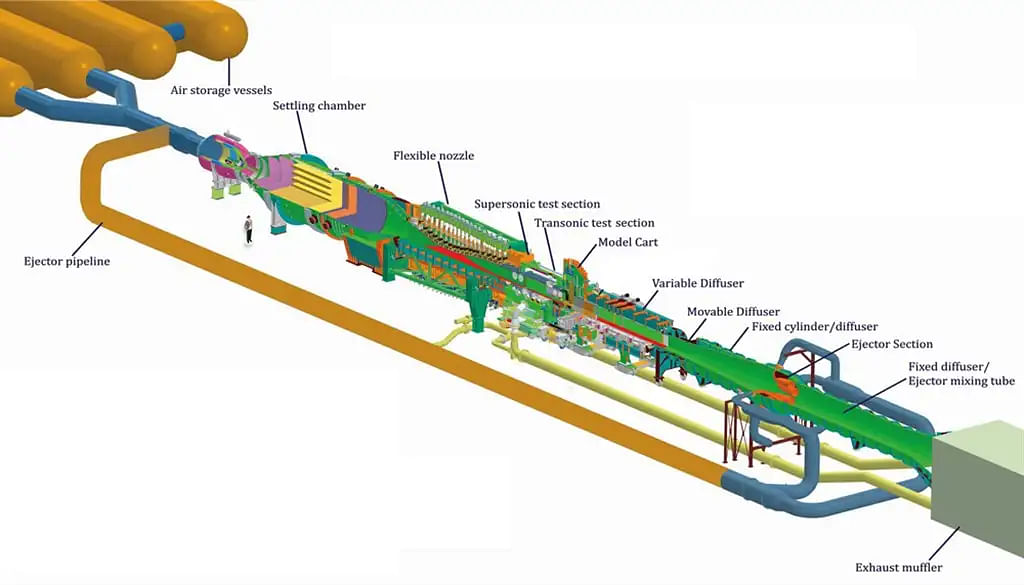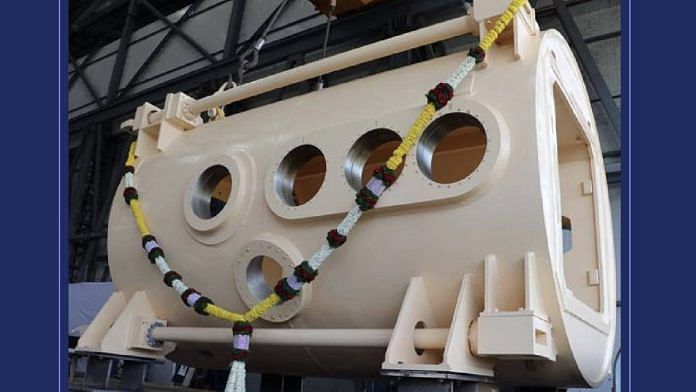On Tuesday, PM Narendra Modi announced three new space projects with a combined cost of Rs 1,800 crore. The projects were announced at Kerala’s Vikram Sarabhai Space Centre, where the names of India’s first four astronaut candidates were also declared. One of the projects announced is a new facility within the space centre itself, called the Trisonic Wind Tunnel. ThePrint explains what the facility will do, in the second of a three-part series.
Bengaluru: The Indian Space Research Organisation (ISRO) has formally inaugurated a first-of-its-kind, large trisonic wind tunnel (TWT) at the Vikram Sarabhai Space Centre (VSSC) in Kerala’s Thiruvananthapuram, which would be used for testing the aerodynamic design of rockets to make them more efficient.
The TWT is India’s third hypersonic wind tunnel (HWT) after the Defence Research and Development Organisation’s HWT at the APJ Abdul Kalam Missile Complex in Hyderabad, and the 1.2 metre TWT at National Aerospace Laboratories in Bengaluru.
The TWT is eponymously capable of operating at three wind velocity ranges: below the speed of sound (subsonic), at the speed of sound (transonic), and above the speed of sound (hypersonic). The facility has been running tests for a year, demonstrating successes. ISRO will utilise the facility to aerodynamically improve rockets, and mainly re-entry-spacecraft, using scaled-down models.
The unique equipment will allow the ISRO to lower costs for overall testing and development of launch vehicles as well as re-entry capsules that will burn through the atmosphere.
India is also one of only three countries to have a wind tunnel that can produce speeds above the speed of sound, after the US and France.
What are wind tunnels?
Wind tunnels are used to test airflow properties and aerodynamic forces, temperature and pressure variation, structural stability of the object being tested, and so on. They are primarily used to test vehicles that fly, like planes and rockets, but also high-speed vehicles on roads like cars and trucks.
They are further used to test buildings and bridges that sway in the wind. Air within these tunnels can move from small wafts to mild breezes to multiple times the speed of sound (hypersonic).
These cylindrical wind tunnels come in various sizes depending on the velocities of wind generated as well as the size of the vehicle.
The tunnel is 160 metres in length with a diameter of 5.4 metres. It is called trisonic, because it has three speed settings with respect to sound: below the speed of sound, at the speed of sound, and above the speed of sound.

It can reach maximum wind velocity conditions of four times the speed of sound (1360 metre per second), with a minimum speed of 0.2 times the speed of sound (68 metre per second). It also contains different sections for different velocity regimen of wind.
The wind tunnel was built by Tata Projects, along with Aiolos Engineering Corporation in Canada. Multiple industry players and small start-ups also participated in building its components, such as Walchandnagar Industries (Pune), Summits Hygronics (Coimbatore), Acoustic India (Trichy), Hydrocare Fluid Power Systems (Bengaluru), Artson Engineering (Nashik), Siemens Energy (Ahmedabad), and more.
About VSSC
The TWT is located within the campus of the VSSC, which is one of ISRO’s various research and testing centers. It is located in Thiruvananthapuram, Kerala. Its main campus is located at Thumba (coastal area within Thiruvananthapuram), and it was formerly known as the Thumba Equatorial Rocket Launching Station (TERLS).
Thumba’s proximity to the equator made it the choice for India’s very first launch station, and it was used since the 1960s to fly sounding rockets (suborbital).
TERLS was dedicated to the United Nations in 1968 by the then-Prime Minister Indira Gandhi, and has been a welcoming home to researchers and scientists from multiple countries over the decades. Over 1,000 USSR weather rockets were launched from here through the 1970s to 1990s.
The now-VSSC is one of ISRO’s largest, and is a complete facility that works on the development of all of ISRO’s rockets. The Space Physics Laboratory, which does research on the atmosphere’s layers, is also located within the campus of VSSC.
VSSC also has facilities in other nearby regions. Valiamala hosts an integration facility while Vattiyoorkavu has a facility for materials development. Aluva is the centre for production of solid propellant fuel.
Current ISRO chairperson S. Somanath was the former director of VSSC until 2022. The centre is currently headed by Dr S. Unnikrishnan Nair, who was formerly the director of Human Space Flight Center in Bengaluru.
(Edited by Nida Fatima Siddiqui)
Also Read: Crucial test for ISRO’s Gaganyaan tomorrow — how crew will escape if mission is aborted



